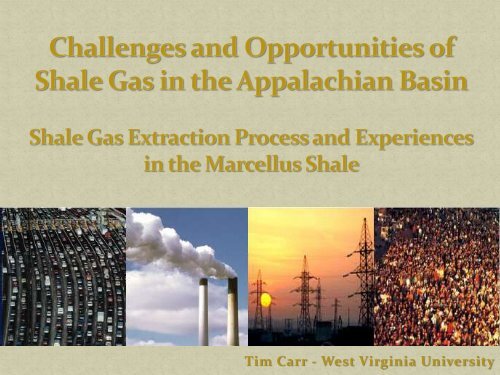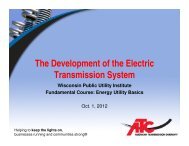Tim Carr - West Virginia University
Tim Carr - West Virginia University
Tim Carr - West Virginia University
- No tags were found...
You also want an ePaper? Increase the reach of your titles
YUMPU automatically turns print PDFs into web optimized ePapers that Google loves.
<strong>Tim</strong> <strong>Carr</strong> - <strong>West</strong> <strong>Virginia</strong> <strong>University</strong>
PersonalObservations, Interpretations & PredictionsDisclaimer - I Do not Represent the State of <strong>West</strong> <strong>Virginia</strong>
Dramatic Increase in Oil and Natural Gas ProductionLargest Increase in Oil and Gas Production in the WorldAppalachian Gas Displacing Gas from the Gulf CoastMidcontinent and Appalachian Liquids Displacing ImportsInsufficient InfrastructurePipeline Expansions and ReconfigurationsConstruction of Oil & Natural Gas Liquid (NGL) Processing and PipelinesExpensive Truck and Rail TransportLNG Import to Export Conversions Challenges and Opportunities Reduced Consumer Prices Increased Business Investment Net Exporter of Petroleum Products Significant gas on coal consumption in power generationCoal Exports Increased (30% compared to last year)Decreased CO2 Emissions
Source: U.S. Energy Information Administration
Building Online GIS DatabaseOf Unconventional Reservoirs
“For the first time since EIA begancollecting the data, generation fromnatural gas-fired plants is virtuallyequal to generation from coal-firedplant”Estimated daily natural gas use toproduce electric power (also calledpower burn) averaged 26.3 billioncubic feet per day (Bcf/d) so far in2012 (Jan 1 - Aug 15), up 24%compared to the same period for2011.Source: U.S. Energy Information Administration, based on Bentek Energy, LLC
Average estimate cost of power generation in the Mid-Atlantic and Southeast,January 2007 – April 2012.
2007 2008 2009 2010 2011 2012Relative Price NYMEX Crude Oil vs. Natural Gas for last Five YearsSource: Wall Street Journal, 15 July, 2012
History 2005 2010ProjectionsConsumptionNet petroleum imports60%Extended PoliciesHigh TTR49%14%36%Domestic supplyU.S. liquid fuel supplymillion barrels per day“Proposed light-duty vehicles fuel economy standards covering vehicle model year 2017through 2025 could further reduce demand for petroleum and other liquids and the needfor imports, and increased supplies from U.S. tight oil deposits could also significantlydecrease the need for imports”Source: EIA, Annual Energy Outlook 2012
Spectra Energy
Extremely Large Resource 1.6 TCF in 2002 500-1,300 Tcf, today Large Area – 16-32 Million Acres in the Core Area Adjacent to the Market Challenges Terrain Infrastructure Public Perception-Tension / OutdatedRegulations and Management Systems History 1821, Fredonia, New York 1926, Big Sandy Field, <strong>West</strong> <strong>Virginia</strong> 2003 Well - Range Resources Approximately 11,543 Wells (96 Plugged)Pennsylvania - 8,602<strong>West</strong> <strong>Virginia</strong> – 2,863Ohio – 29 & New York – 31 6,201 Wells in ProcessLocated in downtown Fredonia, the boulderproudly displays the site of the firstcommercial gas well in the US, dedicated in1925 on the 100th anniversary by theDaughters of the American Revolution.Picture source - http://www.fredonia.edu/shaleinstitute/facts.asp
27 Wells & Locations200 Km
132 Wells & Locations200 Km
440 Wells & Locations200 Km
1,196 Wells & Locations200 Km
3723 Wells & Locations200 Km
3,859 Wells & Locations200 Km
Through 201111,544 Wells & Locations200 Km
8,108 Horizontal Wells & Locations200 Km
Gas Production (Mcf/Month)Liquids Production (Barrels/Month)35,000,00070,00030,000,00060,000Data through December 201125,000,00050,00020,000,00040,00015,000,00030,00010,000,00020,0005,000,00010,00000Month
Annual Gas Production (Bcf)Annual Liquid Production (Barrels)10,000.00Marcellus & Utica Production100,000,0001,000.0010,000,000100.001,000,00010.00100,0001.0010,0000.10Appalachian Basin GasAppalachian Basin Liquids1,0000.01100Year
Annual Gas Production (Bcf)Annual Liquid Production (MBO)10,000.00100,000.001,000.0010,000.00100.001,000.0010.00100.001.000.100.01Pennsylvania Gas<strong>West</strong> <strong>Virginia</strong> GasPennsylvania Liquids<strong>West</strong> <strong>Virginia</strong> Liquids10.001.000.10Year
Annual Gas Production (Bcf)Annual Liquid Production (MBO)10,000.00100,000.001,000.0010,000.00100.001,000.0010.00100.001.000.100.01Pennsylvania Gas<strong>West</strong> <strong>Virginia</strong> GasOhio Utica GasPennsylvania Liquids<strong>West</strong> <strong>Virginia</strong> LiquidsOhio Utica Liquids10.001.000.10Year
Annual Gas Production (Bcf)Annual Liquid Production (Barrels)10,000.00Marcellus & Utica Production100,000,0001,000.0010,000,000100.001,000,00010.00100,0001.0010,0000.10Appalachian Basin GasAppalachian Basin Liquids1,0000.01100Year
WellsRatio Producing to Total Wells10,0000.509,0000.458,0000.407,0000.356,0000.305,0000.254,0003,0002,000Total WellsNon-Producing WellsRatio Producing to Total Wells0.200.150.101,0000.0501 2 3 4 5 6 7 8Year0.00
2001200220032004200520062007200820092010201112,00010,0008,0006,0004,0002,0000Pipeline OperationPipeline ConstructionOil and Gas SupportOperationsOil and Gas ExtractionIndustrial SectorAverage Wage $1,296/weekAvg. WV $725/wkLast Five Years - 2,000+ JobsWV 6,686 DecreaseSource: Workforce <strong>West</strong> <strong>Virginia</strong>, http://www.workforcewv.org/LMI/cntyform2.cfm?SelectCnty=<strong>West</strong>%20<strong>Virginia</strong>Through 3 rd Quarter 2011
State – First Line of RegulationConservation – Well Spacing, DrainageMineral RightsEnvironmental ProtectionProduction Federal – Oversight, Interstate and International Environmental Protection Agency (EPA)Supervise StatesAir Emissions Department of EnergyAuthorizes Import/ExportEnergy Information Agency Federal Energy Regulatory Commission (FERC)Interstate PipelinesGas StorageDepartment of Transportation
GeologyLandShale Gas Work FlowPermitting6 Months to Several YearsDrillingCompletion3 Months to 1 YearInfrastructureProductionAbandonmentDecadesPrimary State Supervision
Water ProtectionSurface WatersFresh Ground Water Horizons Mineral Resources Water ProtectionCoal and Other MineralsOil and Gas Well Control Management Public Health / Safety and Property Waste and Water Management Publicly Owned Lands and Resources
ReservoirWell DepthReservoir PressureRock PropertiesPorosity & PermeabilityBrittlenessOrganic Content Geologic Structure (Seismic Data)FaultingGeosteering EconomicsGas in PlaceProduction RateWell & Infrastructure CostsGas and Liquids Prices
Drilling Location Single or Multi-Well Pad Culture & Surface ConditionsMulti-Well PadSurface Disturbance 6-8 Acres (2.5 – 3.2 Hectares)Drain Approximately 800 Acres (324 Hectares – 3.24 km 2 ) Site Construction & ReclamationSurface Water ProtectionProperty ProtectionErosion and Sediment ControlReclamation Plan
Surface Disturbance – Well Pads, Impoundments, Access Roads and Pipelines
Waste Generation and Management – Closed Loop Systems
SWTarget is:6 meters thick2,ooo+ meters deep1000 meters lateralNE150m
Depth (TVD)5900610063006500670069007100730075007700790081008300850087008900910093009500970099001010010300GammaDIP PROFILE65906610663066506670SEMcCue 28-10HTarget is:6 meters thick2,ooo+ meters deep1000 meters lateral~0.5 ~0.1NW600550500450400350669067106730675067706790Overall Dip = ~0.44° ; Required Inclination = 90.44°300250200150100500Measured DepthWellboreTop of TargetOnondagaTop of Cherry Valley15 per. Mov. Avg. (Top of Cherry Valley)Top of MarcellusBase of TargetTop of PurcellGamma
Gas Btu Content and Associated Liquids Hydraulic Fracture StimulationWater Use and ReusePer Well Use - 3 -10 million gallons20 – 50% FlowbackExtreme High SalinityProppant – Sand (4+ million pounds)OptimizationGroundwater ProtectionCasing & Surface FacilitiesDisclosure of Fracture Chemicalswww.fracfocus.org & State Regulators Production Facilities Pipelines and Compression Liquids Processing
Multiple Stage Hydraulic Fracture Stimulation – Fluid Volumes
Multiple Stage Hydraulic Fracture Stimulation – Complexity
Multiple Stage Hydraulic Fracture Stimulation – Technology and Fracture Design
Completion & FractureOptimization in Gas ShaleCourtesy of Schlumberger
Completion & FractureOptimization in Gas ShaleGoals:● Maximize productive surface area● Perforation placement is critical● Identification of sweet spots● Real time monitoring and controlPlanned Often Realized OptimizedCourtesy of Schlumberger
Automated and Remote Productions Systems – Including Emergency Shut-In Devices
Processing PlantGlycol DehydrationNGL & CondensateTanks
<strong>West</strong> <strong>Virginia</strong> 2011 Annual Gas Production516 Marcellus Wells – 23% of Production~60,000 Other Wells – 77% of Production
OpportunitiesDirect and Indirect Economic RewardsEnvironmental Benefit Challenge -Rapid and Widespread Development Challenge - Rapid Increase In SupplyStress on Physical and Technical and Human InfrastructureChanges in Energy MixStress on Environment – Industrial Activity Challenge - Governmental DemandsRegulatory SystemsManagement Systems Challenge - Public Outreach
1979 Energy Policy ActNatural Gas Restricted from Electric GenerationGas Shale Research Program Section 29 Tax CreditsMitchell Energy - Barnett Challenge - Governmental DemandsRegulatory SystemsManagement Systems Challenge - Public Outreach
<strong>Tim</strong> <strong>Carr</strong>Phone: 304.293.9660Email: tim.carr@mail.wvu.edu






![[Hybrid Synergy Drive Knowledge is Power]](https://img.yumpu.com/35232059/1/190x143/hybrid-synergy-drive-knowledge-is-power.jpg?quality=85)



